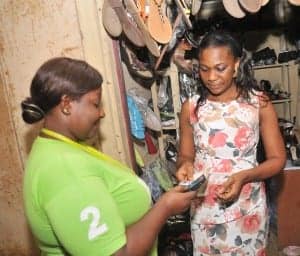Say you’re a woman living in the developing world, and you’re working to save money. In fact you’re a conscientious saver, generally squirreling away 10 to 15 percent of your earnings while still managing the household budget and frequently loaning to family members in need. Yet you have little access to formal banking, perhaps because the nearest bank is simply too far away to visit regularly.

Women’s World Banking research finds that most low-income women are diligent savers who nonetheless face daunting cultural and institutional obstacles to saving. Low literacy rates and education levels, discriminatory laws and practices, time constraints and other factors that vary from country to country are just some of the barriers to women’s financial inclusion. Data from the World Bank’s 2014 Global Findex Database show that 46 percent of men in developing economies have bank accounts versus 37 percent of women.
Digital savings accounts have the potential to narrow that 9 percent gap. [Tweet “Digital savings for women can be a game-changing oppty that paves the way for financial inclusion.”]
 A new Women’s World Banking report on digital savings, “Digital Savings: The Key to Women’s Financial Inclusion?,” looks at how introducing digital financial services for women can be a game-changing opportunity that paves the way for financial inclusion. Digital savings accounts can introduce women to formal banking by providing a convenient, reliable, confidential and secure means of saving. It’s also a win for banks: convenience boosts account activity rates which allows banks to get to know clients’ risk profiles. Reliability, confidentiality and security also builds trust among women who tend to be more loyal and reliable customers. But financial institutions must tread carefully—success depends on approaches that fully take into account women’s needs.
A new Women’s World Banking report on digital savings, “Digital Savings: The Key to Women’s Financial Inclusion?,” looks at how introducing digital financial services for women can be a game-changing opportunity that paves the way for financial inclusion. Digital savings accounts can introduce women to formal banking by providing a convenient, reliable, confidential and secure means of saving. It’s also a win for banks: convenience boosts account activity rates which allows banks to get to know clients’ risk profiles. Reliability, confidentiality and security also builds trust among women who tend to be more loyal and reliable customers. But financial institutions must tread carefully—success depends on approaches that fully take into account women’s needs.
“Right now, digital financial services are not widespread,” says Women’s World Banking’s Jennifer McDonald, Product Development Manager for Savings, “but the potential is there. If you design it right, women will take up a digital product. And while our approach is to design with women in mind, the product should also be appealing to men. And typically,” she adds, “our experience shows that what works for women, works for men as well.”
Women’s World Banking examined how various financial institutions, mobile network operators and even governments are successfully bringing digital financial services to low-income women. Based on their success as well as our own research and experience developing digital financial services, here are five best practices that financial institutions should consider when designing digital savings products:
- Streamline account-opening processes. Making account-opening processes easier often involves restructuring state regulations so banks can offer a wider, more women-friendly range of options. The State Bank of Pakistan replaced a biometric information requirement for accounts with lower balances by allowing agents to digitally photograph clients and their IDs in their homes, businesses or shops. As a result, Pakistan’s UBL Omni bank agents are now able to help clients open accounts simply by visiting them in their home or business.
- Bundle digital accounts with other financial needs. To help women save for specific goals, such as paying for children’s education, the KCB M-Pesa account in Kenya created “sub-accounts” with higher interest that allow for targeted goals and fixed-term accounts of up to 12 months. If they need to, women can dissolve the accounts to access their money in emergencies.
- Create direct links between clients and providers. Reduced distance, risk and costs of transactions is one of digital banking’s greatest benefits. Nigeria’s Diamond Bank and Women’s World Banking combined many best practices in developing its BETA Savings account. After spending time talking with women entrepreneurs in the Lagos outdoor markets, we developed a plan that brings bank agents to women at their workplace to make digital savings and withdrawals easier; markets to women with simplified language and strong visuals; collects women-specific data; bundles savings with other digital services, and more.
- Tailor marketing and training to women. If women are to become consumers of bank products, it means creating attractive products and informing women about the products and how they work. In Indonesia, Bank BTPN used extensive client and focus group research to create nine “personas” to help staff tailor products to different customers’ needs. In Malawi, the local language was used in marketing materials designed to convey information to women in a simple, inviting way.
- Build trust. Research shows that women tend to adopt new financial services more slowly than men. In Peru, Scotiabank recruits a variety of different agents to assist with their digital account openings. If new clients are not comfortable with self-service tools, they can be assisted by agents, who include local women-owned business, call centers, as well as the clients’ employers.
Of course, experience has shown that financial institutions will not necessarily design and deliver successful digital financial services on their own, especially digital savings accounts, which are uniquely positioned to accelerate women’s financial inclusion. Those who are committed to financial inclusion must do our part to raise awareness of the potential of the women’s market opportunity, promote comprehensive research of women’s needs and preferences in each country context, rigorously test emerging practices and promote the collection of gender-disaggregated data. These are critical steps to prove that women-focused digital savings accounts can be the key to financial inclusion for women.



